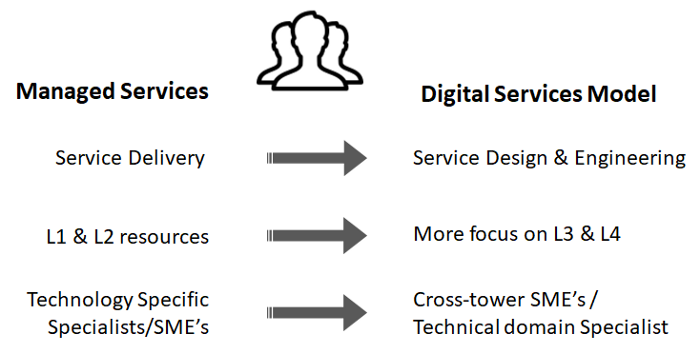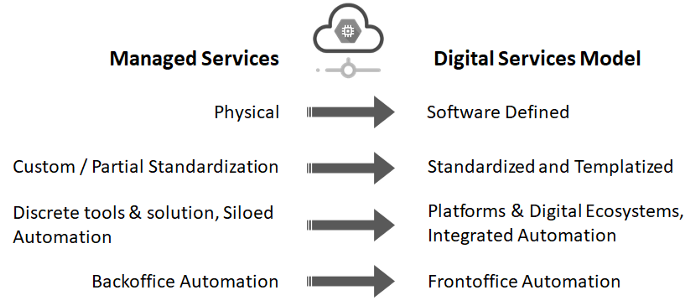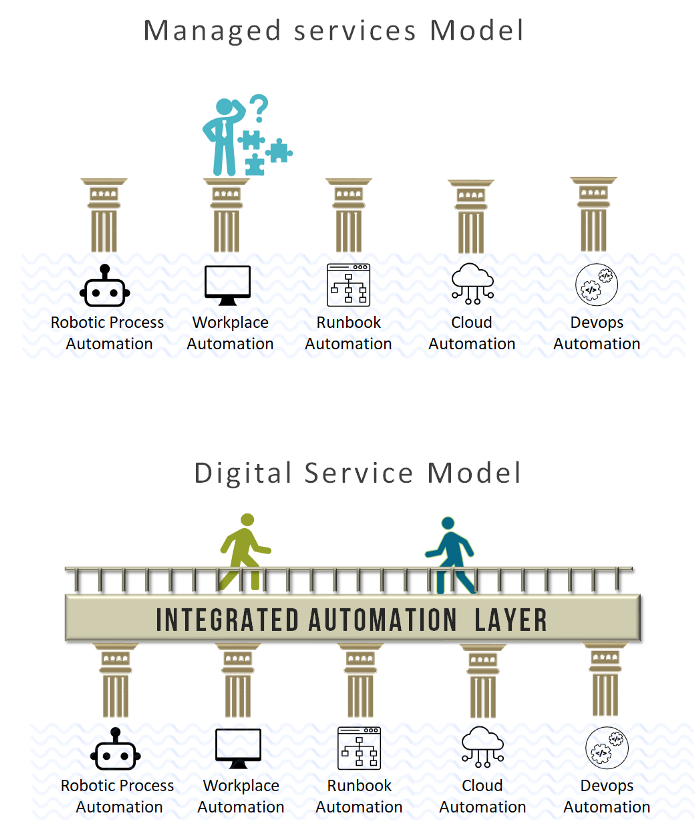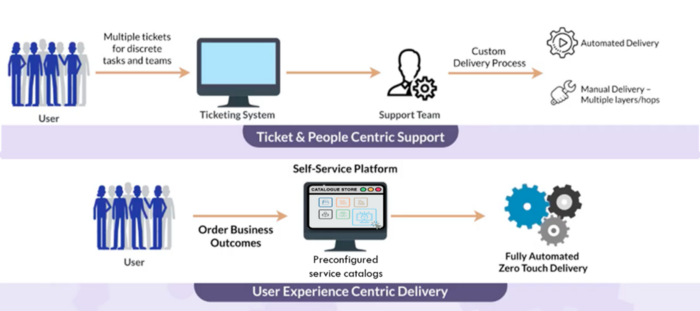The catalog centric world will usher in major changes to Enterprises. Get ready to adopt Service Design & engineering, Product management rhythm, performance metrices for UX, software-defined services layer etc., and a whole lot of interesting changes as Service Deilvery will shift its focus on consumer grade user experience.

In our previous blog, we saw what the Digital Service Model is and how it enables an operational shift in the organization and provides better business agility, speed of delivery and a consumer grade user experience.
Let us see how the new model will impact Enterprises from a people, process and technology perspective.


i) Nearly 80% of the efforts for support personnel today are focused on Service Delivery, attending to the tickets raised by users. This will shift in the Digital Service Model upstream towards Service design and engineering.
Service Design and Engineering will take over from traditional Service Delivery, where more than 80% of the efforts are being spent.
ii) Focus for the people today is around L1 and L2. This will shift towards L3 and L4. We will need cross functional roles. The responsibilities for support personnel will include defining technology standards, creating reference architectures etc.,
iii) Organizational structure today is siloed, and roles played by support team are broken by Towers — that are Technology specific. In the Digital Service world, we will be assembling cross functional services that includes technical and business services on the go. There will need for people that can handle both technology and domain expertise ex: Banking domain experts, Retail industry experts etc.,
iv) We will also require new skills like Site Reliability Engineers (SRE)to eliminate the need for support, customer experience specialists, solution designers and Developers, Product managers etc.,
Newer roles will emerge. We will start to see CX specialists and Product managers in Service Delivery world

i) The current model is highly process-centric and follows an ITIL rhythm. In the Digital Service model, delivery follows a product rhythm with a product engineering process. We use design thinking to collaborate with users and identify services that needs to be developed and create a service road map. We use a lean approach for building services efficiently and agile methodology for iterative development by working closely with key stakeholders.
ii) The metrics today are more ITIL aligned, ex: MTTR, average resolution time, service availability and so on. The metrics in the new world will move towards service analytics, where we take a 360 degree view of the way sevices are delivered. This will include service usage metrics, spend metrics, customer experience metrics, service availability metrics and so on.
UX index will be a measure of success in Service Delivery. This is dependant on percentage of self-services , percentage of digitized services, User ratings and average time for delivery
iii) In managed services model, ticket is core to everything we deliver today. All service improvements are structured around the ticket. The centre of gravity will now shift towards the catalog in the Digital Service model, where everything will start to revolve around the catalog.
Catalog is the center of Digital Service Model

i) Enterprises are already moving to a software defined world. The underlying infrastructure including server, storage, network etc., are already moving into software-defined world. Now IT services will also move into a software-defined world where Service is a piece of code . It is exposed to the users as a catalogue.
ii) Lot of these services today are custom-built or partially standardized. If 100 users are ordering a service, the delivery is not consistent and comes through in multiple ways. In the new Digital Services world, services are highly standardized and templatized. Every single time the service is ordered it follows the exact same pattern and maintains consistency.
iii) From an automation perspective, most of Organizational investments today or on discrete tools and solutions. They are highly siloed. Lot of these automation tools have boundaries. What you can automate today is limited by the boundaries of the tool. In the Digital Services world, as we design and create complex business services that are outcome focused, we will need an integrated automation approach where the delivery of a single service can span across multiple tools and platforms. We also start leveraging more platforms and digital ecosystems. Each Enterprise system or tool is seamlessly able to integrate and work with other tools and platforms in the ecosystem.

v) Automation today is backend focused and makes the life of Enterprise admins a lot easier . The automation efforts in Digital Service model, will shift the focus towards the user at the front end . Any service they order will be delivered to them directly and instantly. ( see comparison of the two models below)

In summary, Enteprises will reinvent themselves from a people, process and technology perspective as they evolve to a new Digital Sevice Delivery model. Organizational agility is a collective quotient of a lot of these changes that Enterprises should be bold enough to adopt.
